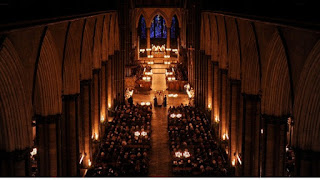The architecture of a Laudian Advent
With the season of Advent falling in the darkest time of year, darkness is caught up in the Advent hope. Darkness holds us at the beginning of the Advent procession; it is evoked in the ancient Advent hymn Conditor alme siderum/'Creator of the Stars of Night'; and is the theme of Cranmer's collect for Advent III, 'Lord, we beseche thee, geve eare to our prayers, and by thy gracious visitacion lighten the darkenes of our hearte, by our Lorde Jesus Christe'.
De templis points to the Advent quality of darkness, encouraging devotion, bringing us to seek the Lord's Advent:
The number of windoores ought to observe the grace of the whole structure, which if they be not of common glasse, but painted, adorne the Church with a glorious light, and moderate that bright light, which is a hinderance to devotion. The Utopian Temples, saith Sr T: More, were subobscura, some what dark: Nec id aedificandi inscitiâ factum sed consilio Sacerdotum, quod immodica lux cogitationes dispergit [over much light doth disperse cogitations, whereas in dimme and doubtful light they be gathered together, and more earnestly fixed on religion and devotion]. For devotion requires collected spirits, which light diffuses, as Sir H: Wotton seems to interpret him in his Elements of Architecture. And we find it by experience, that in our light Churches, did not wee close our eyes, wee could hardly keepe our thoughts from distractions till the end of a short collect. And I verily believe that the holy fervour of devotion was more intense in the primitive Christians dark obscure vaults, than hath ever beene in our lightsome Churches.
The opening words of the Advent Procession call us to turn in heart and mind towards the ancient land of Abraham and the prophets, 'I look from afar: And lo, I see the power of God coming'. Throughout the days of Advent, we heed the words of Baruch, "Look towards the east, O Jerusalem". And we look for the coming dawn, "O Dayspring, Brightness of Light Everlasting, and Sun of Righteousness".
De templis emphasises (in good Laudian fashion) the significance of the altar placed at the east end of the church - "Our Communion Tables, being now placed at the East end, close to the wall not to bee danced about, as in former times" - as an expression of waiting in Advent hope:
And the man who enters the West doore from farre beholding the Altar where he seriously intends to offer his devotions to his God and Saviour, shall find his devout soule, more rapt with divine awe and reverence, more inflamed with pure and holy zeale, in the delay and late approach unto it, than if at first he had entered upon it.
Finally, there is also a Marian quality to Advent season, reflected in the hymns of the season - such as the traditional Alma Redemptoris Mater - and in our waiting mirroring that of the Blessed Virgin before the Lord's Nativity, herself an embodiment of the waiting of the Daughter of Sion over long centuries.
De templis also points to the Marian character of the church where Word and Sacrament are celebrated and Christ is thus present, for herein the Christian temple reflects the vocation of the Blessed Virgin:
The other Temple, which may also be truly called a Temple, dedicated to God, is his most-chaste and immaculate Mother, the blessed Virgin Mary, of whose structure God himselfe tooke such care, that some of the Roman Church hold opinion, shee was not polluted with any, no not Originall sinne. Surely this Temple, was richly dect with all beauteous vertues, which God the Father from all eternity elected, and prepared for himselfe, which was over-shaddowed with the power of the Most-high, and in which for the space of nine moneths, the body of our blessed Saviour, really inhabited.
The rich theology of the design and adornment of churches in De templis is suggestive of how our churches - in their interplay of darkness and light, their orientation to the east, and the Marian quality of their purpose - are signs of the Advent hope throughout the year, while also deepening our experience of that hope during the season itself.
*It is worth noting that the use of 'temple' to describe Christian churches is found in the Book of Homilies, 'An Homily on the Right Use of the Church or Temple of God': the materiall Church or Temple is a place appointed aswell by the usage and continuall examples expressed in the olde Testament, as in the New". Similarly, Hooker compares Christian churches to "the first temple built by Salomon" (LEP V.15.3) and notes that, at the ending of imperial persecution and the arrival of "Emperors favouringe sincerelie the Christian truth ... Temples were all places erected" (V.11.2).




Comments
Post a Comment